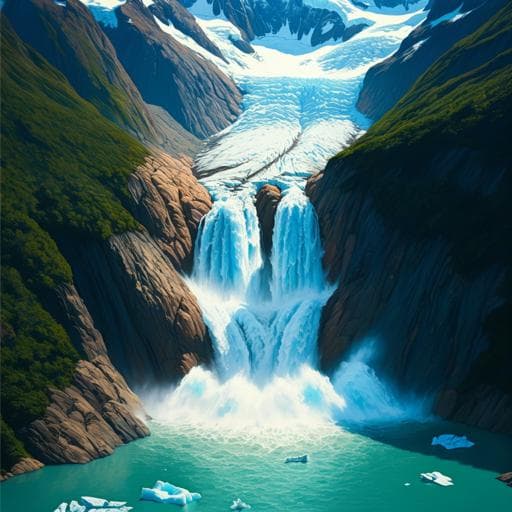
Earth Sciences
Abrupt drainage of Lago Greve, a large proglacial lake in Chilean Patagonia, observed by satellite in 2020
S. Hata, S. Sugiyama, et al.
This research conducted by Shuntaro Hata, Shin Sugiyama, and Kosuke Heki reports a significant outburst of Lago Greve in Chilean Patagonia, where the lake level plummeted by 18.3 meters, resulting in a massive discharge of 3.7 km³ of water. With advanced satellite techniques revealing the dynamics behind this event, this study showcases the remarkable potential of modern technology in monitoring glacial lake outbursts.
~3 min • Beginner • English
Introduction
The study investigates a sudden, large-scale drainage (GLOF) from Lago Greve, a major glacier-fed proglacial lake on the western side of the Southern Patagonia Icefield (SPI). Globally, glacial lakes have expanded in number, area, and volume in recent decades as glaciers retreat, influencing glacier dynamics, frontal ablation, freshwater fluxes, sedimentation, and downstream ecosystems and hazards. With anticipated increases in GLOF frequency as lakes form and expand, there is a critical need to monitor these systems and understand outburst mechanisms. Remote sensing offers global capabilities to detect and quantify lake changes (area, level, and volume), but applications to large, rapid outburst events remain limited, and GRACE/GRACE-FO gravimetry had not previously been applied to GLOFs. In April 2020, satellite observations revealed abrupt shoreline retreat at Lago Greve, motivating a detailed multi-sensor analysis to quantify lake area, level, and volume changes, assess gravity-field signals, and infer the outburst mechanism. The purpose is to document one of the largest satellite-era GLOFs, evaluate the ability of satellite techniques to capture it, and examine implications for glacier-lake systems.
Literature Review
Prior work documents rapid worldwide growth of glacial lakes since 1990 and associated impacts on glacier dynamics and mass loss. Studies in Patagonia, Alaska, the Himalaya, and Greenland show enhanced glacier retreat tied to lake formation and expansion. Satellite imagery and altimetry have been used to map lake extents and measure water levels and DEM-based elevations. GRACE and GRACE-FO have quantified water mass changes in larger lakes and reservoirs, but had not been applied to GLOFs. Historical large GLOFs include: Perito Moreno dam-breach events (1954–1956) draining ~5.2 km³; repeated outbursts in the Northern Patagonia Icefield (e.g., Cachet Lake ~0.2 km³ in 2008); Icelandic jökulhlaups from Grímsvötn (up to ~4.5 km³); and Hubbard Glacier’s 1986 event (~5.4 km³). Mechanisms triggering GLOFs include dam breach via overtopping from waves (calving, landslides, rockfalls), seepage through moraines, ice-dam flotation, and spontaneous moraine failure. Anticipated increases in GLOF frequency are seen as a lagged response to climate-driven glacier retreat.
Methodology
- Lake area: Measured using 19 Sentinel-2 MSI (10 m) and Landsat 8 OLI (30 m) images from 28 Sep 2016 to 1 Nov 2020. Lake margins were manually delineated on false-color composites (Sentinel-2 bands 8/4/3; Landsat 8 bands 5/4/3). NDWI was used to aid water delineation in shaded areas. Uncertainty was estimated by Monte Carlo perturbation of polygon nodes within pixel resolution (SD ±0.02 km²). Glacier frontal changes were also mapped (ice-front position uncertainty ±7 m).
- Onset timing: Inspected Sentinel-1 SAR backscatter (4.4 m) images on 9 and 19 Apr 2020 and compared with optical images on 8 Apr and 5 May 2020 to identify changes in lake margin and outlet stream course.
- Lake water level: Combined ICESat-2/ATLAS L3A ATL13 inland water elevations (Nov 2018–Jul 2020) with DEM-derived shoreline elevations. DEMs: SRTM-DEM (Feb 2000; 30 m; vertical uncertainty ±7 m) for pre-drainage periods and a 5 m WorldView-2 stereo photogrammetric DEM (WV-DEM; 21 Jul 2020; vertical accuracy ±5.6 m) for post-drainage periods. DEM vertical offsets were corrected by comparison with ICESat-2 within seven days (mean offsets: +2.5 m for SRTM, +1.4 m for WV-DEM), excluding the drainage period.
- Terrain and mechanism analysis: Compared DEMs (Feb 2000 vs Jul 2020) to quantify elevation changes near the outlet, analyzed stream flowline migration and bank erosion, and examined cross-sections across the outlet valley.
- Gravity field (GRACE/GRACE-FO): Used CSR RL06 mascon solutions resampled to 0.5° grids. Computed mass-change time series averaged within 200, 300, and 400 km radii around Lago Greve (reflecting 200–400 km effective resolution). Modeled 2002–2019 variations with linear, seasonal (annual/semiannual), and decadal terms: M(t)=(k1 sin t + k2 cos t)+k3 t+k4. Evaluated 2020–2021 residuals and fitted an additional linear mass-loss term from 8 Apr to 29 Jul 2020. Mapped March–August 2020 spatial mass changes after removing 2002–2019 mean seasonal differences.
- Data and tools: QGIS for mapping; MATLAB 2018b and M_Map for figures; data from USGS, Copernicus SciHub, CSR GRACE; ERA5 reanalysis consulted for weather context.
Key Findings
- Event timing and magnitude: Abrupt drainage began between 9 and 19 April 2020. From 8 Apr to 29 Jul 2020, lake level dropped by 18.3 ± 1.2 m (12.3 ± 2.7 m by 29 Apr), and lake area decreased by 14.5 ± 0.02 km². By 1 Nov 2020, area stabilized at 187.9 ± 0.02 km² (7.2% reduction from 8 Apr).
- Discharge volume: Total water release was 3.7 ± 0.2 km³ (3.7 ± 0.2 Gt), equivalent to 31 ± 8% of the annual SPI ice mass loss (2000–2015/16) and ~0.01 mm global sea-level rise. This ranks among the largest satellite-era GLOFs.
- Mechanism: Pre-event, the outlet stream was deflected west by a ~100 m-long vegetated bump at the top of the waterfall. Post-event (by 21 Jul 2020), the bump had collapsed; the stream shifted northeast by several hundred meters over ~250–300 m up/downstream, and vegetation in the intervening zone vanished, indicating bank erosion. DEM differencing (2000 vs 2020) showed >30 m elevation loss between the lake and waterfall, with mean changes along flowlines of −24.7 ± 5.6 m (pre-event path) and −33.7 ± 5.6 m (post-event path). Cross-sections show the northern bank lowered by ~20–30 m; the thalweg shifted ~100 m north and deepened by ~20 m, commensurate with lake level drop. Interpretation: Collapse of the bump triggered a channel avulsion and rapid headcutting/erosion of unconsolidated LIA morainic and lacustrine sediments, lowering the outlet control and draining the lake.
- Trigger assessment: No evidence for calving-induced waves, nearby landslides/rockfalls, or anomalous melt/precipitation (ERA5). A M5.2 earthquake on 5 Apr 2020 at ~200 km distance was likely too weak/early to be causal. Precise trigger remains undetermined.
- GRACE signal: Mascon time series within 200–400 km show a 2020 negative anomaly inconsistent with modeled trends/seasonality. Fitting an additional April–July 2020 mass-loss term yields −0.29 ± 0.03 m w.e. (200 km), −0.23 ± 0.02 m w.e. (300 km), and −0.17 ± 0.02 m w.e. (400 km), spatially localized near Lago Greve. The implied volumes (33.4–58.5 km³) greatly exceed the actual 3.7 ± 0.2 km³ due to GRACE’s coarse spatial resolution; nonetheless, GRACE successfully detected the event qualitatively.
- Context: The outburst volume is comparable to historically large events (e.g., Perito Moreno 1954–56 ~5.2 km³; Hubbard 1986 ~5.4 km³; Grímsvötn up to ~4.5 km³) and far exceeds typical Patagonian GLOFs such as Cachet Lake (~0.2 km³).
Discussion
The study demonstrates that a large proglacial lake outburst can be detected, constrained in onset, and quantified in magnitude using a combination of optical/SAR imagery, satellite altimetry, and DEM differencing, with independent qualitative confirmation from satellite gravimetry. The findings support the hypothesis that local geomorphic threshold failures at outlet controls (here, collapse of a small topographic bump) can trigger rapid channel avulsion and headward erosion that drive substantial lake-level drawdown. GRACE/GRACE-FO mascons are sensitive enough to register regional-scale signals of such events, but quantitative volume estimates are strongly biased by spatial leakage and coarse resolution. The event likely represents a delayed geomorphic response to past glacier retreat and moraine deposition near the outlet. Implications for glacier dynamics include expected changes in terminus stress balance, potential speed adjustments analogous to tidal forcing on marine-terminating glaciers, altered calving frequency/magnitude, and modified subaqueous melt rates; long-term monitoring of calving glaciers around Lago Greve is warranted to assess these impacts.
Conclusion
A major GLOF occurred at Lago Greve between April and July 2020, with a lake-level drop of 18.3 ± 1.2 m, area loss of 14.5 ± 0.02 km², and discharge of 3.7 ± 0.2 km³—among the largest satellite-era events. Multi-sensor satellite analyses indicate the outburst was triggered by collapse of a small bump at the outlet waterfall, causing channel redirection and rapid erosion of the outlet valley. GRACE/GRACE-FO detected a clear mass-loss signal localized near Lago Greve, but overestimated discharge due to inherent spatial resolution limits. The study highlights the capability and complementarity of satellite imagery, altimetry, photogrammetry, and gravimetry for monitoring GLOFs. Future work should include field surveys to identify triggering mechanisms and material properties at outlets, development of higher-resolution or localized gravimetric solutions for better quantification, and continued monitoring of glacier dynamics and lake levels to assess post-outburst responses.
Limitations
- No in situ lake depth measurements; discharge derived indirectly from surface area and level changes.
- Precise trigger of the outlet bump collapse remains unknown; lack of local seismic/field observations limits attribution.
- GRACE mascon solutions have coarse spatial resolution, causing large overestimation of discharge volume and spatial leakage; not suitable for precise quantification of single-lake events.
- Lack of nearby weather stations; reliance on ERA5 reanalysis may miss localized meteorological extremes.
- DEM-based shoreline elevations carry vertical uncertainties (SRTM ±7 m; WV-DEM ±5.6 m) and require offset corrections; rapid level changes during drainage precluded some cross-calibration.
Related Publications
Explore these studies to deepen your understanding of the subject.







